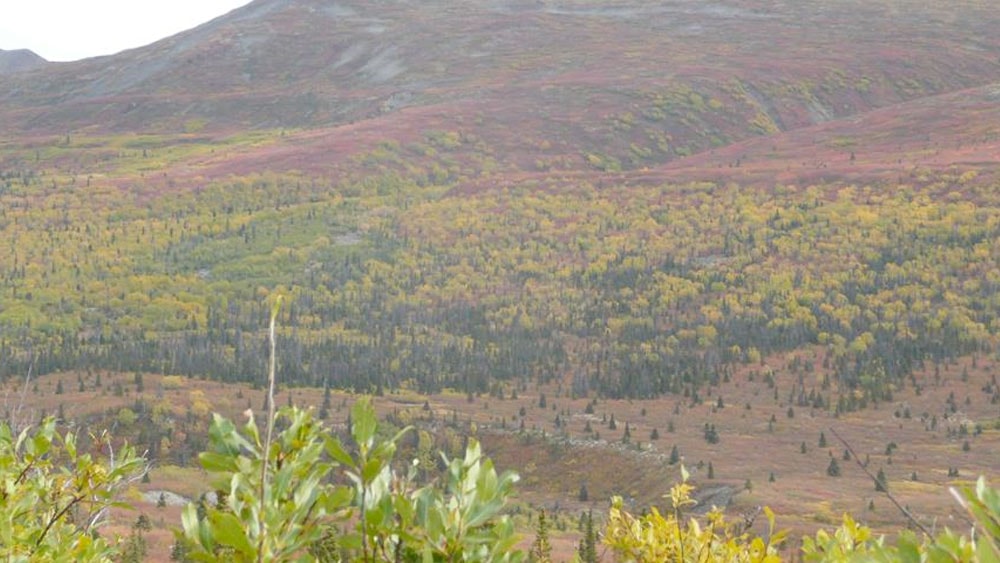Last fall, I took a solo trip to hunt moose in the backcountry of Alaska’s Chugach Mountains. Ten years ago, my friend Bart Schleyer passed away on a solo moose hunt in the Yukon, and I planned my trip as a memorial to him.
I arrived in Alaska on September 5, and after waiting two days at the hanger for weather to improve, I flew to a remote river drainage in the Chugach. I set up camp and began glassing the area for moose. I immediately saw several cows in the distance and an immature, 40-inch bull. I also spotted a nice bull with three by three brows and a spread slightly over 50 inches. Excitement mounted as I settled into camp for the night.
The next day I got up before dawn, and at first light I spotted three bulls together on the first shelf above the river 1.5 miles away. I went after them. The biggest bull went high on the opposite hillside so I dropped down and crossed the river after him. Soon, I lost the bull and didn’t have good wind to continue. I looked back and saw one of the other bulls on the other side of the river going toward my camp. I pulled up my hip waders and crossed the river again.
After calling on several set-ups, I lost him. I continued up the valley, and decided to explore the upper basins first since moose tend to summer high. I could then concentrate my calling effort down in the thick spruce at lower elevation once the rut picked up and the bulls started cruising.
That afternoon, I was resting and eating jerky when I heard a bull grunt. I sat up and saw him coming toward me. He was a good bull with over 24 points, but his palm edges were parallel and turned in. He could have been over 50 inches and legal, but I didn’t want to chance it. At 40 yards, he caught my scent and lumbered away.
I continued, and after reaching the high ridge and glassing the upper drainages, I decided to turn back. I had only seen a few more cows.
With a little over an hour of daylight left, I spotted a good bull about a half-mile past my tent on the same side hill. I dropped down and hurried closer to get a better look. It was the same bull I had seen earlier, and my excitement ebbed. But then, I saw another bull lower down the side hill. At 150 yards, I could see he was much wider, so I got low and moved closer. I crawled on my hands and knees, then dropped to my belly for the last 70 yards, staying below their line of sight, and using the dwarf birch as cover.
They were both above me, but I had a good wind and the cool evening down thermals worked to my advantage. Glassing through the brush, I could see the bull had good swoop to his beams and flared palms with long side tines. He didn’t have many brow points, only two on left and three on right, but his rack sure looked to be over 60 inches wide.
Both bulls were preoccupied and racking brush, which allowed me to get among them. The upper bull kept looking in my direction, but he never knew I was there. I finally slid my pack off and crept up behind a spruce sapling. The wait was on. The sun was setting. I could get no closer.
Finally the upper bull moved down to the same plane as the wide one. The wide bull viewed the encroached personal space as a threat and turned toward him. But once the upper bull backed off, mine turned around and headed up toward me. I glanced ahead and looked for a shooting lane, then back at the upper bull. His head was down feeding. Now all my attention went to the wide bull, and I rose to my feet. He came up the trail a little more, but I remained behind the spruce at 30 yards. I thought about shooting, and then about the clear lane. I waited.
He moved forward with his head down, and turned to look over his shoulder. This gave me a rare chance to turn my feet and take a perfect stance. I thought to shoot low in the chest. He took a step and stretched his front leg forward. The 66# Schleyer model Stalker recurve, made for me by South Cox, came all the way back and the long shaft was on its way. I saw my white fletching hit tight behind the shoulder as I heard a crack.
My fear of hitting a leg bone was only momentary as the great bull lunged forward, ran thirty yards, and died in 20 seconds.
Since I knew he was down, I got my pack and went to him from the behind while the first bull was watching me from a safe 80-yard distance. It was now a rush to record the recovery and get a few photos before darkness fell.
I cut up the bull and cooled out the meat in the dark. I always find this part rewarding, and I thought of Bart as I worked. It was after midnight by the time I got back to my tent. The moon was bright and the sky clear. The temperature had dropped below freezing so the night was perfect for cooling meat.
The next day, I packed everything out, and I thought of Bart as I forded streams, climbed up through the willow brush, and found grizzly scat and tracks. Even in places as remote as the Chugach, we are never truly alone. The wilderness holds company in the animals we encounter, and the friends we remember. Peace to you.
